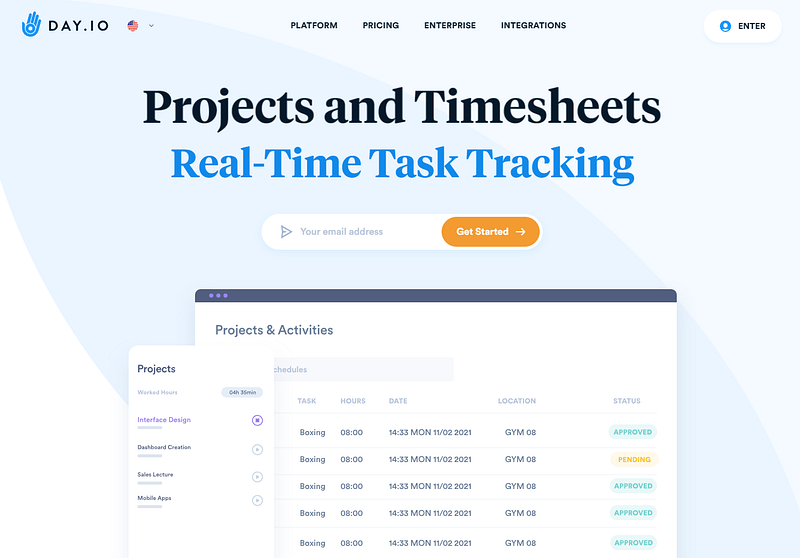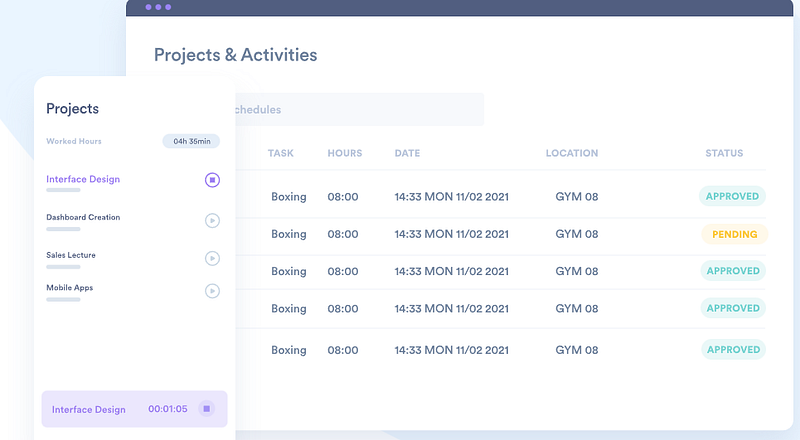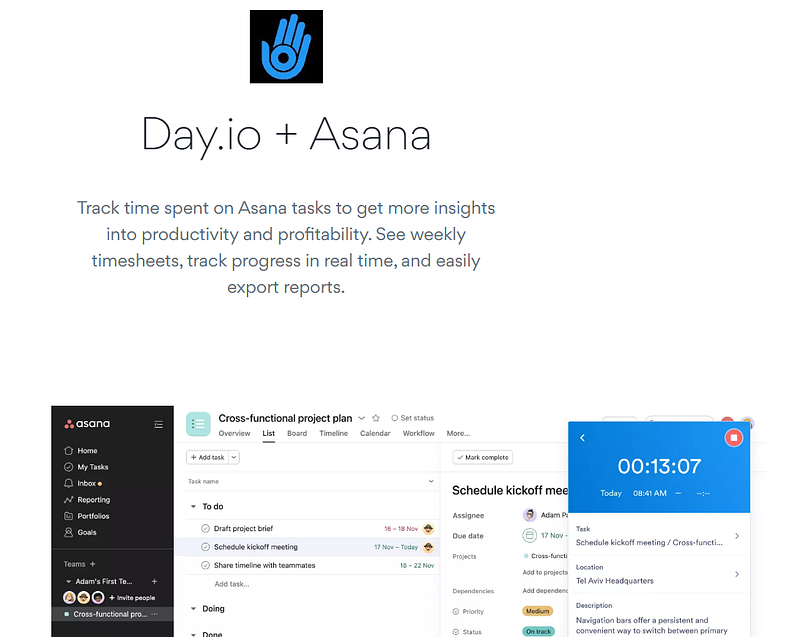Every successful project manager is aware of the importance of tracking time for their tasks. Whether your scope is small or large, having an accurate understanding of how long each task takes to complete can make all the difference.
Asana has become one of the most popular task management tools available today, and it also makes it easy to keep track of time spent on each task — helping you manage multiple projects successfully and improve your company’s ROI.
This article will discuss how to use Asana’s built-in features as well as step-by-step instructions for taking your time tracking capabilities even further with some helpful plugins. Let’s get started!
Is There Native Time Tracking In Asana?
The answer, unfortunately, is no. At the moment, Asana does not have a native time tracking feature. Time based project management is limited to the “due date” feature, which allows you to set deadlines for tasks.
You can, of course, work around this by manually entering the amount of time you spent on a task, but this isn’t ideal as it’s not really an efficient way to track progress. Why? Here are a few reasons:
Errors & omissions
Manually entering the amount of time you spent on a task requires manual effort, which can be prone to errors and omissions. It’s also not ideal for tracking progress over the long-term as it doesn’t provide an accurate picture of how much time you’ve actually spent on any given task.
Plus, think of the self-interest bias when it comes to time tracking. How often have you been tempted to overestimate the amount of time you’ve spent on a task, given that you’re paid for the amount of time you put in? Apply that mindset to a team of 10 or more people and you have the potential for inaccurate time tracking.
Difficulty in staying organized
Manually entering the amount of time you spend on a task means that you have to remember when and how long you spent on it. This can quickly become cumbersome, especially if there are multiple tasks to track or if your team is spread across different locations.
Perhaps the biggest issue with manual time tracking is that it can quickly become disorganized and overwhelming. With so many tasks to keep track of, you may end up forgetting which tasks you’ve already completed, how long they took, or even the amount of time left on a project.
Lack of real-time visibility
Manually entering the amount of time you spend on a task also means that there is no real-time visibility into how much time has been spent on any given task. This means that it’s difficult to accurately track progress and make decisions about which tasks need more attention or resources.
You also can’t see who’s logging in real-time, so there’s no way to tell if a team member is working on the task or not at a glance. This feature is essential for managing remote teams, as it allows you to ensure everyone is on the same page and working towards the same goals.
Limited ability for robust time tracking reports
Finally, manually entering the amount of time you spend on a task impairs your ability to generate comprehensive and accurate time tracking reports. Without a real-time picture of how much time is being spent on any given task, it’s difficult to determine if you are staying within budget or meeting deadlines.
What’s the solution?
Luckily, Asana has strong integration capabilities, allowing users to connect their task management software with external services and tools for more detailed analysis and reporting.
We’ll get into the best platforms for Asana time tracking in a moment. But first: why would you want to track the time spent on each task anyway? Let’s discuss a few of the benefits:
Why Should We Track Time In Asana?
Tracking time spent on tasks in Asana can be incredibly useful for a range of reasons.
- Accurate Estimation: Firstly, tracking time enables project managers to accurately predict the amount of time needed for specific tasks. This can be incredibly useful when it comes to planning projects and setting deadlines.
- More Efficient Resource Allocation: Additionally, Asana’s time tracking integrations help project managers make better decisions about resource allocation. By understanding how long individual tasks take, teams can focus their efforts on the most critical and lengthy activities while allocating resources more effectively.
- Team Productivity Analysis: Moreover, using Asana for time tracking allows you to create detailed reports that show how productive team members are and how quickly they complete tasks. Time tracking data can help teams identify any potential bottlenecks or areas where additional resources may be required.
- Billing Clients: For companies that charge clients based on working hours, time tracking makes it much easier to track and invoice clients accurately for hours worked.
- Prioritizing Tasks: Finally, by taking advantage of Asana’s integrations we’re able to determine which jobs are taking longer than expected – enabling us prioritize these tasks appropriately or reassign extra resources if necessary.
Now that we’ve discussed why utilizing Asana’s integration set is so beneficial, let’s look at exactly how you might go about precisely timing your workload.
How To Track Time In Asana Properly?
As mentioned previously, Asana does not have an integrated time tracking system, so you’ll need to install a third-party extension.

Day.io is one of the most popular and reliable Asana plugins for this purpose. It allows you to easily monitor how much time each task requires, as well as generate detailed reports for stakeholders.
Before getting started with time tracking in Asana, let’s learn about how to download the Day.io extension.

Step By Step On How To Get Day.Io Extension
The Day.io extension is available on the Asana App page, and it’s easy to integrate using these steps:
- Step 1: Create a Day.io account with your name, business email address, and contact number. Make sure to take advantage of the free “Pro” trial for three days!
- Step 2: Once you log in to your Day.io account, look for browser extensions – install the one that says ‘Day.io’.
- Step 3: Go to your Asana settings page then click on Extensions; there you’ll find an option to add or install the Day.io extension onto Asana directly!
- Step 4: After installation is complete, a control panel and time tracking dashboard will be embedded within your Asana interface so that you can invite team members and start using it right away!

Benefits of Tracking time in Asana with Day.io
The Day.io extension for Asana can bring many advantages to your team, including:
- Weekly Timesheet: Each team member will have an accurate overview of their weekly timesheet, with time spent on individual tasks, projects or sub-tasks shown clearly.
- Hassle-free Setup: With just one click you can set up the tracking without having to go through any complex configurations.
- Real-Time Tracking: When time tracking is enabled through Day.io a real-time report of task progress and status is generated in the dashboard.
- Continuous Synchronization: There’s no need to manually adjust settings when creating or importing new tasks as the Day.io extension automatically links each task within a project so it’s visible on the timesheet report too!

Now let’s take you through a list of top Asana time tracking tools!
What’s The Best Time Tracking In Asana?
Finding the right time-tracking solution for Asana can be a daunting task, so to make your search easier we have compiled a list of the best plugins available. Check out our recommendations and select one that meets your needs!
1. Day.io – Overall The Best Time Tracking in Asana
Day.io’s Asana extension provides an array of time tracking features, enabling you to accurately monitor the amount of time spent on tasks and projects. Through Day.io, you can generate precise reports, facilitate effortless collaboration between team members, set up smart reminders and implement dynamic goal-tracking capabilities.
It’s especially useful for teams that need to track time across multiple projects, as it allows you to easily switch between tasks and view the amount of time spent on each one. This feature makes it easy to track progress at a glance, while also ensuring that no effort is wasted or overlooked.
The extension also provides insights into team performance by tracking individual productivity over time, enabling you to make informed decisions about resource allocation and project management.

Features
- Automated and real-time insights on project progress and profitability
- Time tracking for individual tasks and sub tasks
- Generating detailed time report
- Time off management
- Check-in and check-out tracking
- Customized settings for early-exit and late-entry
- Exporting project reports in several formats
- Complete visibility of weekly timesheets
- Cost and billing management from timesheets
- Digital signature management
- Anti-fraud measures, including GPS verification and SIM authentication
Pricing
Day.io offers two separate plans – time tracking and project tracking.
- Project tracking: $8 per user/month
- Time tracking: $5 per user/month
You can also try the platform with a 3-day free trial of the pro plan.
2. Timely – Best for Automated Time Tracking in Asana
Timely is the perfect Asana time tracking plugin for project managers and team members who prefer to keep things simple with automated processes. Over 5,000 businesses use Timely and its developers claim that integrating it with Asana can reduce your administrative workload associated with time management by up to 75%.

Features
- Time tracking for each task, project, and team
- Complete coverage for all billable activities
- Native integration and connectivity through API
- Team member authorization and empowerment tools
- Plan tracking within daily, weely, or monthly calendar view
- Data visualization tools and reporting
- Protection of team trust through zero screenshot or key-stroke monitoring policies
- Compatibility with multiple devices and operating systems
- Integration with major project management and office platforms, including Google Calendar, QuickBooks, Zapier, Zoom, and many more
Pricing
- Starter: $10 per user/month – Supports 50 projects and 3 teams
- Premium: $18 per user/month – Unlimited projects and teams
- Unlimited: $26 per user/month – Unlimited project and team, with individual capacity planning and team lead assignment
3. Hubstaff — Most Affordable Time Tracking for Asana
Hubstaff provides an affordable time tracking solution for Asana, enabling you to accurately monitor individual tasks and projects. Among the few solutions in the market that provide screenshots and activity-based tracking, Hubstaff ensures that you stay informed about how your team members and employees are progressing with their tasks. Moreover, connecting with Asana is made simple through Hubstaff’s Chrome extension.

Features
- Timesheet tracking and generation with easy toggle button
- Daily and weekly views
- Configurable weekly budget and time allocation
- Billable and non-billable hours configuration
- Timesheet approval management with automated approval for individual users
- Lockable timesheet
- Idle time and real-time activity detection through keystroke monitoring
- Timesheet, attendance and time off reports
Pricing
Hubstaff offers three distinct packages, each designed to suit different needs. Hubstaff Time is an easy-to-use time tracker, while Hubstaff Desk provides advanced managerial features. For complete remote team management and GPS connectivity, opt for the Hubstaff Field package.
- Desk Free: $0, free for one user
- Desk Starter: $5.83 per user/month
- Desk Pro: $8.33 per user/month
In addition, you can also opt for a few add ons for task management, data retention, insights.

Wrap-Up: Track Time in Asana
Time tracking is essential for any project management system, and Asana offers extensive solutions to do so. Connecting hundreds of third-party tools with its easy-to-use interface, you can track the time spent on each task with ease.
One of the best plugins available today is Day.io – a powerful extension that provides excellent capabilities for accurately tracking the time allocated and used towards tasks in your projects.
With Day.io’s tool, you’ll be able to better manage resources more efficiently than ever before!
Try it out with our 3 day free trial to see what it can do for you!
